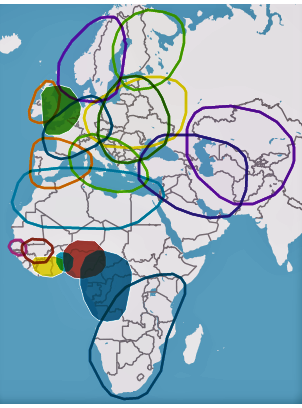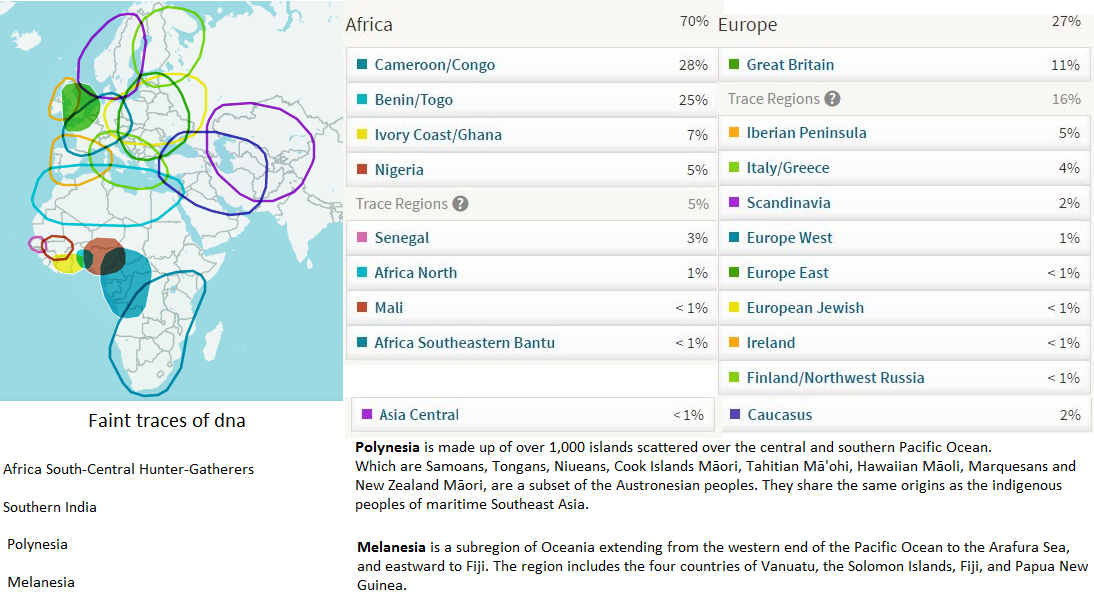For this result I used AncestryDNA
I used this company because they have the largest database. When I first read the results & saw this map, I wasn’t really shocked. I knew I was of mixed heritage. It also explains and help me understand my appearance. I’m mostly composed of African & European Ancestry. Like many in the Americas and other African descendants abroad were especially interested in who we are. Getting to know your self is always a good thing.
I must say I was slightly surprised by the Caucasus region aka Caucasus mountains on my chart, which composes of and primarily located in: Armenia, Azerbaijan, Georgia, Iran, Iraq, Syria, Turkey. My trace regions are also found in: Bulgaria, Jordan, Greece, Italy, Kuwait, Palestine, Romania, Turkmenistan.
If I can recall correctly I think that area was ruled by the Persian Empire. Maybe they intermarried in the past. This might be why genetically people are similar in this modern day region.

Since I’m in search of self, I must admit this test gave me some closure. Granted it’s an ethnicity estimate percentage, but it’s a start. What struck me a bit, was that I was not native to any one specific region/land. Typical natives on my chart seems to be around 60%-92%. My highest ethnic percentage is 28% in the areas of Cameroon, Gabon, Congo, Republic of Congo Also found in: Angola, Chad all combined.
The “Examples of Native People” chart shows individual ethnicity estimates for five sample individuals native to each region. Individuals whose family trees suggest deep ancestry in a particular region are considered “native” to that region. AncestryDNA has gathered thousands of these “native” DNA samples from across the globe. Members of our native sample collection are unique because their family has lived in their region for centuries. Yet, even these natives are not 100% similar to their own region. That is because every region has some degree of admixture.
-AncestryDNA
Remember that when your looking at this chart below, it’s not just a chart. These were human beings/living souls.

Nonetheless I was pleasantly surprised by the Cameroon region because I’m a sea food lover. This explains to me as to why it’s instinctively part of my diet.
Portuguese sailors found crayfish in the Wouri River and started calling the land the Rio dos Camarões, or River of Shrimp.
My Benin / Togo genetic results also found in the region of Ghana, Nigeria & Mali had Great African Kingdoms, metallurgy (the branch of science and technology concerned with the properties of metals and their production and purification) and art in the past.
Ivory Coast/Ghana at 7% is pretty cool. My love for gold might have come from there.
Early French and Portuguese explorers identified sections of the West African coast by the area’s resources, which is how Côte d’Ivoire, or Ivory Coast, got its name. Neighboring Ghana was known as the Gold Coast.
The highest European percentage I have is Great Britain, this might explain why I’m a tea drinker. Who knows, according to science there is memory and behavioral traits in your DNA.
Epigenetic inheritance is an unconventional finding. It goes against the idea that inheritance happens only through the DNA code that passes from parent to offspring. It means that a parent’s experiences, in the form of epigenetic tags, can be passed down to future generations.
The Iberian Peninsula which is listed under my European bloodline / descendants is a mountainous region that’s most associated with the countries of Spain and Portugal. It also includes Andorra and a small part of France along its northeastern edge, as well as Gibraltar on its south coast, a small peninsula which forms an overseas territory of the United Kingdom. You can see this on the right side of the chart. My trace regions are also found in: France, Morocco, Algeria & Italy.
As for the Mediterranean area and Scandinavia primarily located in: Sweden, Norway, Denmark. My trace regions can also be found in: Great Britain, France, Germany, Netherlands, Belgium, the Baltic States & Finland.
Kind of made sense to me since the people in that region were seafaring people, invaders, well-traveled merchants and tradesmen.
Remains of an African woman who died more than 1,000 years ago during Saxon times in Britain, Europe
East African:
Also I noticed that some East African You-tubers complained that the company has not built enough samples from East Africa and categorizes everyone from the east as Africa Southeastern Bantu.
Native American:
Also some people of Native American descent had some issues with their DNA results not showing their Indian ancestry.
I suggest using promethease.com (there is a $5 fee), but you can use GEDmatch and DNA.land for free. Use this if you need results to be extremely accurate based on your known ancestry.
Keep in mind that each genetics company has it’s own database.
Choosing a DNA testing company – ISOGG Wiki
The traditional definition of race and ethnicity is related to biological and sociological factors respectively. Race refers to a person’s physical characteristics, such as bone structure and skin, hair, or eye color. Ethnicity, however, refers to cultural factors, including nationality, regional culture, ancestry, and language.
An example of race is brown, white, or black skin (all from various parts of the world), while an example of ethnicity is German or Spanish ancestry (regardless of race) or Han Chinese. Your race is determined by how you look while your ethnicity is determined based on the social and cultural groups you belong to. You can have more than one ethnicities but you are said to have one race, even if it’s “mixed race”.
–Ethnicity vs Race – Difference and Comparison | Diffen
An ancestor or forebear is a parent or (recursively) the parent of an ancestor (i.e., a grandparent, great-grandparent, great-great-grandparent, and so forth). Ancestor is “any person from whom one is descended. In law the person from whom an estate has been inherited.”
Two individuals have a genetic relationship if one is the ancestor of the other, or if they share a common ancestor from the past. In evolutionary theory, species which share an evolutionary ancestor are said to be of common descent. However, this concept of ancestry does not apply to some bacteria and other organisms capable of horizontal gene transfer.
Assuming that all of an individual’s ancestors are otherwise unrelated to each other, that individual has 2n ancestors in the nth generation before him and a total of about 2g+1 ancestors in the g generations before him. In practice, however, it is clear that the vast majority of ancestors of humans (and indeed any other species) are multiply related (see pedigree collapse). Consider n = 40: the human species is more than 40 generations old, yet the number 240, approximately 1012 or one trillion, dwarfs the number of humans who have ever lived.
Ignoring the possibility of other inter-relationships (even distant ones) among ancestors, an individual has a total of 2046 ancestors up to the 10th generation, 1024 of which are 10th-generation ancestors. With the same assumption, any given person has over a billion 30th-generation ancestors (who lived roughly 1000 years ago) and this theoretical number increases past the estimated total population of the world in around AD 1000. (All of these ancestors will have contributed to one’s autosomal DNA: this excludes Y-chromosomal DNA and mitochondrial DNA.)
Some cultures confer reverence to ancestors, both living and dead; in contrast, some more youth-oriented cultural contexts display less veneration of elders. In other cultural contexts, some people seek providence from their deceased ancestors; this practice is sometimes known as ancestor worship or, more accurately, ancestor veneration.
Interesting articles on this subject
http://www.nanalyze.com/2016/04/codis-the-worlds-largest-dna-database/

Hello Sola. Thank you for the information that you provided here. We have a similar make up related to locations and percentages so a lot of what you’ve indicated touches home with me also. I’ve attached a copy of my results. Thank you again for taking time out to share your research.
https://uploads.disquscdn.com/images/866504ea0d7b0a8f55e39acb528b19ed5a6d6c02fb80eaa43ab62c46f2744ba2.png
Your welcome.
Thank You for sharing your results also. Now others won’t feel so alone or awkward when they find out that their results is not what they expected. This may also explain their appearance & possibly demeanor (Epigenetics & Inheritance)